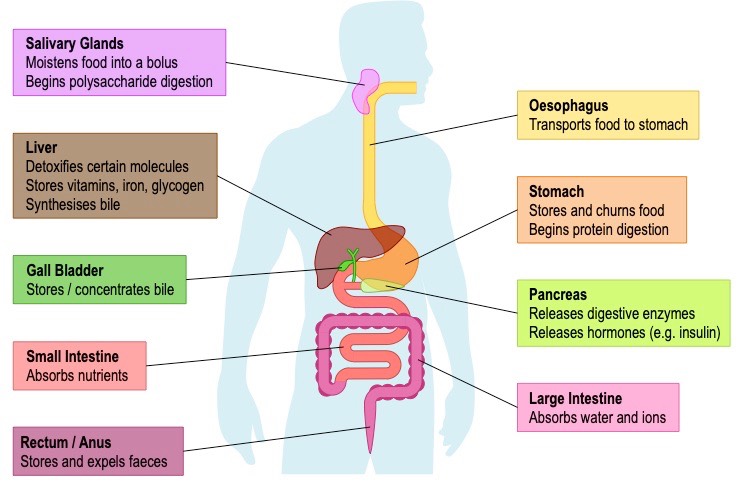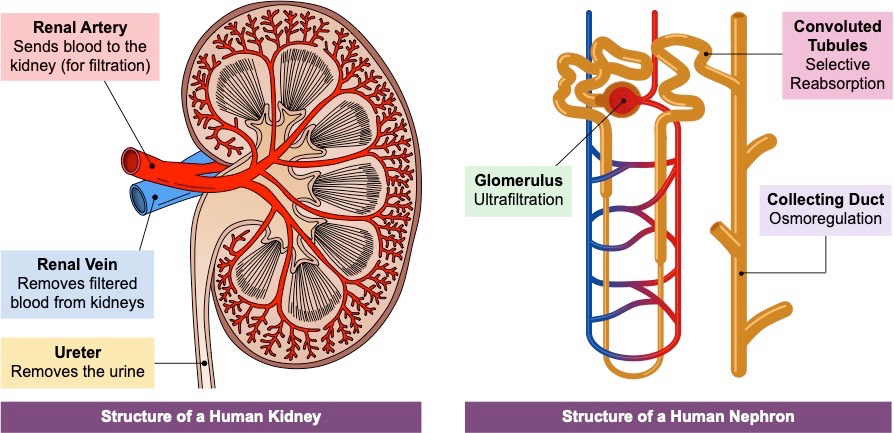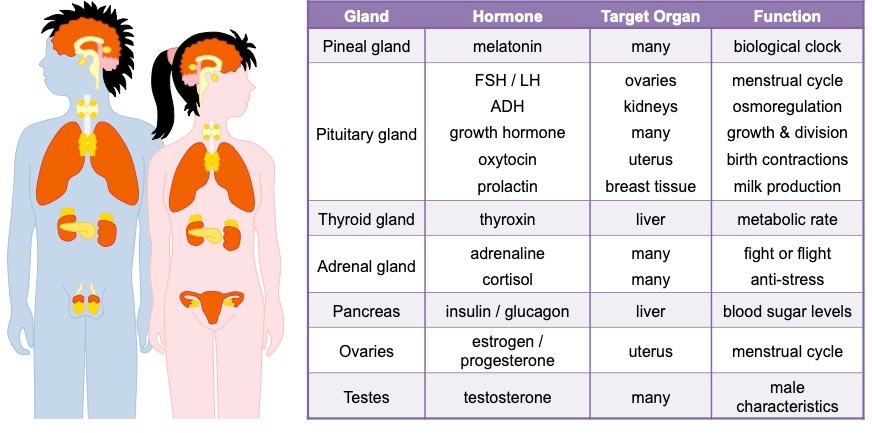Key Knowledge:
|
Animals possess a variety of specialised tissues, organs and organ systems in order to maintain metabolic and homeostatic processes
- The cardiovascular, respiratory, digestive and excretory systems collectively function to move and exchange materials
- The nervous, hormonal and skeletomuscular systems are involved in detecting and responding to internal and external stimuli
- Other organ systems include the integumentary system (skin), the reproductive systems and the lymphatic (immune) system

Digestive System
The digestive system is primarily involved in the break down and absorption of ingested food materials (which are assimilated by cells)
- There are two major groups of organs which comprise the digestive system: the alimentary canal and accessory organs
The alimentary canal consists of the digestive organs through which the food passes (oesophagus, stomach, small & large intestine)
- The oesophagus is a hollow tube connecting the oral cavity to the stomach, which moves food via the action of peristalsis
- The stomach is a temporary storage tank where food is mixed in an acidic environment (pH < 2) and protein digestion begins
- The small intestine is a long and folded tube with a high SA:Vol ratio, where usable food substances (nutrients) are absorbed
- The large intestine is the final section of the alimentary canal, where water and dissolved minerals (i.e. ions) are absorbed
The accessory organs aid in digestion but do not actually transfer food (salivary glands, pancreas, liver, gall bladder)
- The salivary glands release saliva to moisten food and contains enzymes (e.g. amylase) to initiate starch breakdown
- The pancreas releases numerous enzymes into the small intestine and also secretes certain hormones (e.g. insulin, glucagon)
- The liver takes raw materials from the intestine and metabolises them (its role includes detoxification, storage and bile production)
- The gall bladder stores the bile produced by the liver and releases it into the small intestine (bile salts are used to emulsify fats)
Any ingested food that is not absorbed is eliminated via the anus as faeces (also in the faeces are bile pigments and human flora)

Excretory System
The excretory system is primarily involved in water regulation and the removal of nitrogenous waste products produced by cells
- The organ involved is the kidneys, which filter the blood and funnel nitrogenous wastes (as urea) into the bladder for excretion
The kidneys contain specialised structures called nephrons, which filter the blood and eliminate wastes via three key processes:
- Via ultrafiltration, the blood is filtered by a basement membrane which prevents cells and large proteins from passing into the filtrate
- Then selective reabsorption occurs within the tubules, whereby useful materials (ions, amino acids, etc.) are returned to the blood
- Finally, water loss is controlled via osmoregulation, because the tubules are selectively permeable to water (i.e. cannot freely cross)
Consequently, the urine that is excreted from the body will differ in composition from the blood that entered the kidneys for filtering
- Urine should not contain any blood cells or proteins or reabsorbed nutrients (such as glucose), provided the kidneys are functioning
- However, urine should contain high levels of urea and variable levels of water (depending on the hydration status of the individual)

Endocrine System
The endocrine system consists of a network of ductless glands that release chemicals into the bloodstream to regulate body functions
- A hormone is a chemical messenger released from an endocrine gland that is transported via the blood to act on distant target cells
- Hormones are specific and will only activate the cells or tissues that possess the appropriate target receptor
- The endocrine system is slower to initiate, but has a more prolonged response when compared to the nervous system
Endocrine glands secrete their product (hormones) directly into the blood, rather than through a duct (as per an exocrine gland)
- Major endocrine glands include the pancreas, adrenal gland, thyroid gland, pineal gland and the gonads (ovaries and testes)
- The hypothalamus and pituitary gland are neuroendocrine glands and function to link the nervous and endocrine systems
- Some organs may also secrete hormones despite not being endocrine glands (e.g. adipose tissue secretes leptin)
